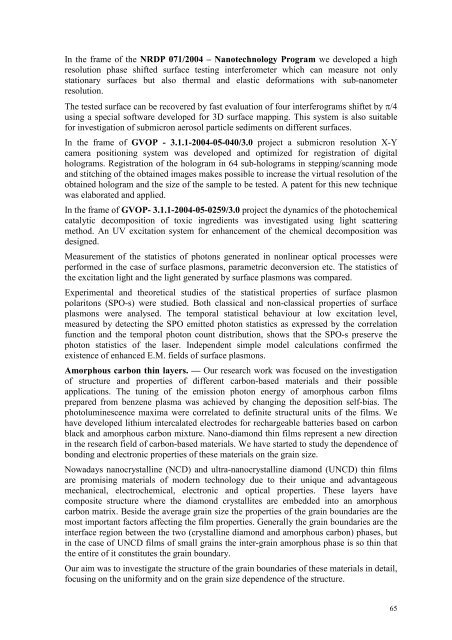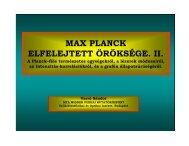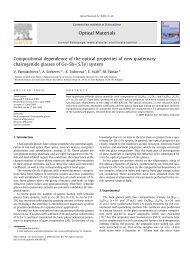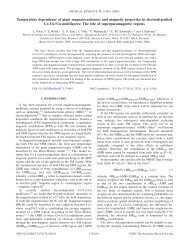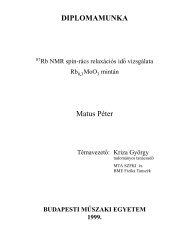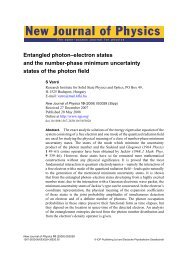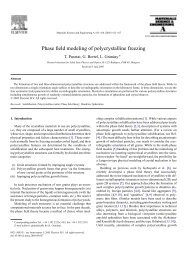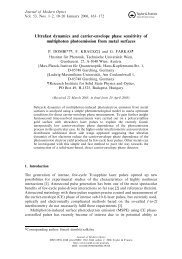ANNUAL REPORT - MTA SzFKI
ANNUAL REPORT - MTA SzFKI
ANNUAL REPORT - MTA SzFKI
You also want an ePaper? Increase the reach of your titles
YUMPU automatically turns print PDFs into web optimized ePapers that Google loves.
In the frame of the NRDP 071/2004 – Nanotechnology Program we developed a high<br />
resolution phase shifted surface testing interferometer which can measure not only<br />
stationary surfaces but also thermal and elastic deformations with sub-nanometer<br />
resolution.<br />
The tested surface can be recovered by fast evaluation of four interferograms shiftet by π/4<br />
using a special software developed for 3D surface mapping. This system is also suitable<br />
for investigation of submicron aerosol particle sediments on different surfaces.<br />
In the frame of GVOP - 3.1.1-2004-05-040/3.0 project a submicron resolution X-Y<br />
camera positioning system was developed and optimized for registration of digital<br />
holograms. Registration of the hologram in 64 sub-holograms in stepping/scanning mode<br />
and stitching of the obtained images makes possible to increase the virtual resolution of the<br />
obtained hologram and the size of the sample to be tested. A patent for this new technique<br />
was elaborated and applied.<br />
In the frame of GVOP- 3.1.1-2004-05-0259/3.0 project the dynamics of the photochemical<br />
catalytic decomposition of toxic ingredients was investigated using light scattering<br />
method. An UV excitation system for enhancement of the chemical decomposition was<br />
designed.<br />
Measurement of the statistics of photons generated in nonlinear optical processes were<br />
performed in the case of surface plasmons, parametric deconversion etc. The statistics of<br />
the excitation light and the light generated by surface plasmons was compared.<br />
Experimental and theoretical studies of the statistical properties of surface plasmon<br />
polaritons (SPO-s) were studied. Both classical and non-classical properties of surface<br />
plasmons were analysed. The temporal statistical behaviour at low excitation level,<br />
measured by detecting the SPO emitted photon statistics as expressed by the correlation<br />
function and the temporal photon count distribution, shows that the SPO-s preserve the<br />
photon statistics of the laser. Independent simple model calculations confirmed the<br />
existence of enhanced E.M. fields of surface plasmons.<br />
Amorphous carbon thin layers. — Our research work was focused on the investigation<br />
of structure and properties of different carbon-based materials and their possible<br />
applications. The tuning of the emission photon energy of amorphous carbon films<br />
prepared from benzene plasma was achieved by changing the deposition self-bias. The<br />
photoluminescence maxima were correlated to definite structural units of the films. We<br />
have developed lithium intercalated electrodes for rechargeable batteries based on carbon<br />
black and amorphous carbon mixture. Nano-diamond thin films represent a new direction<br />
in the research field of carbon-based materials. We have started to study the dependence of<br />
bonding and electronic properties of these materials on the grain size.<br />
Nowadays nanocrystalline (NCD) and ultra-nanocrystalline diamond (UNCD) thin films<br />
are promising materials of modern technology due to their unique and advantageous<br />
mechanical, electrochemical, electronic and optical properties. These layers have<br />
composite structure where the diamond crystallites are embedded into an amorphous<br />
carbon matrix. Beside the average grain size the properties of the grain boundaries are the<br />
most important factors affecting the film properties. Generally the grain boundaries are the<br />
interface region between the two (crystalline diamond and amorphous carbon) phases, but<br />
in the case of UNCD films of small grains the inter-grain amorphous phase is so thin that<br />
the entire of it constitutes the grain boundary.<br />
Our aim was to investigate the structure of the grain boundaries of these materials in detail,<br />
focusing on the uniformity and on the grain size dependence of the structure.<br />
65


